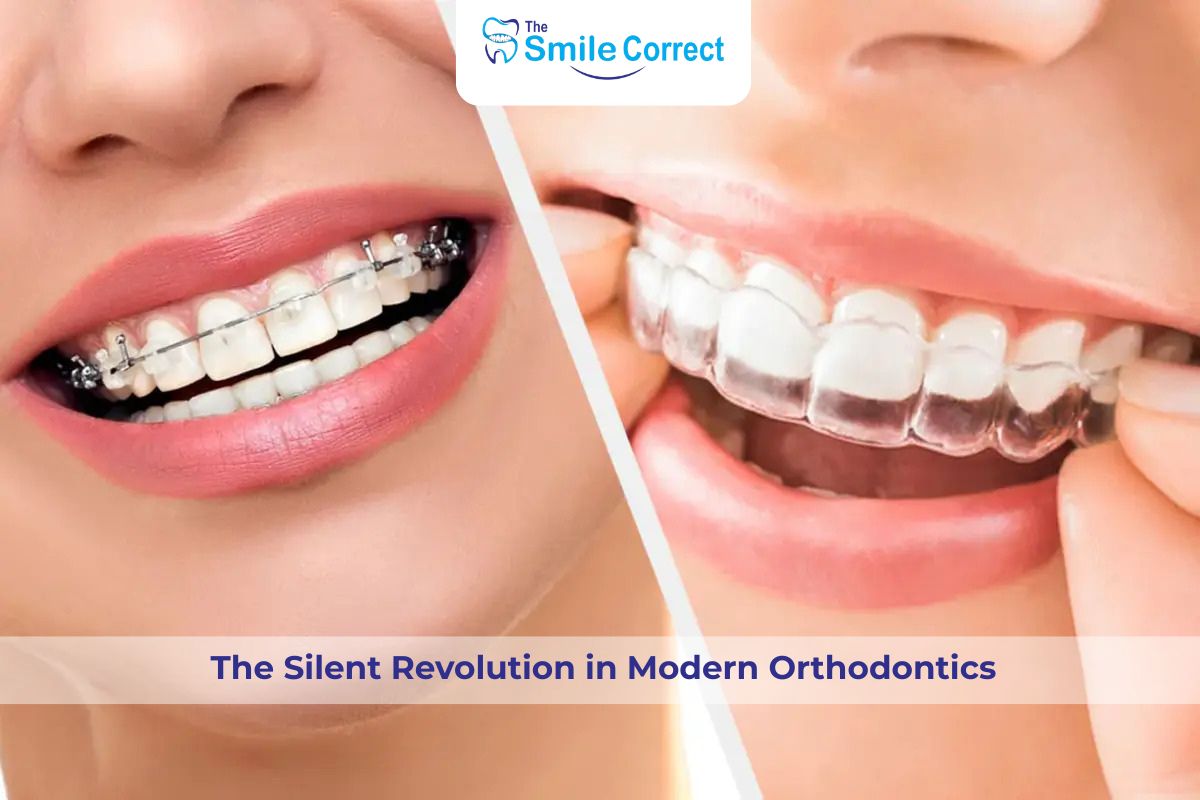
You’ve probably heard the whispers—more adults are getting braces than ever, and yet, you don’t see them sporting wires and brackets. Welcome to the age of invisible braces: orthodontics’ quiet revolution that’s straightening teeth without screaming for attention.
From tech-savvy teens to professionals in boardrooms, clear aligners have become the go-to solution for those seeking a straighter smile—minus the metal mouth. But there’s more to invisible braces than just aesthetics. In this article, we unpack the layers behind this orthodontic innovation, demystify the options, and offer an inside look into what makes them a game-changer in dental care.
Invisible braces refer to orthodontic appliances that align teeth with minimal visual presence. These are typically made from medical-grade, transparent plastic and are designed to be removable, unlike traditional fixed braces.
They go by various names:
But the poster child of this movement? Clear aligners. Sleek, removable trays that nudge your teeth into place without anyone noticing.
It’s not just vanity that’s fueling the rise of invisible braces. There are real, tangible reasons they’ve become the preferred choice:
1. Discreet Appearance
For adults in corporate environments or teens navigating self-esteem challenges, visible metal braces can be a hurdle. Invisible braces offer orthodontic correction without the social anxiety.
2. Comfort and Convenience
Made of smooth, BPA-free plastic, clear aligners eliminate the poking wires and bracket-induced sores that come with traditional braces. Plus, they’re removable—eat what you want, brush without fuss.
3. Easier Hygiene
Since aligners can be taken out, maintaining oral hygiene is significantly easier. You brush and floss as you normally would, reducing the risk of cavities and gum issues.
4. Fewer Clinic Visits
Thanks to digital treatment planning, patients often receive multiple sets of aligners at once and require fewer orthodontist visits.
5. Predictable Outcomes
Most clear aligner systems are planned using digital simulations. Patients can see a 3D preview of their post-treatment smile before they even start.
1. Clear Aligners
These aligners come in custom-made sets and must be worn 20–22 hours a day.
2. Ceramic Braces
Traditional braces get a subtle twist. These use tooth-colored or clear brackets, sometimes paired with translucent wires.
3. Lingual Braces
Think of these as the introverts of orthodontics—they hide behind your teeth.
Let’s get technical—but not boring.
1.Digital Scanning: Instead of sticky impression molds, a digital scanner maps your teeth in 3D.
2.Treatment Planning: AI and orthodontist input determine how your teeth will shift with each aligner.
3.Custom Tray Production: Each tray is slightly different, applying gentle pressure to move your teeth gradually.
4.Regular Switching: You swap trays every 1–2 weeks.
5.Monitoring Progress: Either through in-person visits or virtual check-ins.
The total treatment time? Anywhere from 3 months to 2 years, depending on complexity.
In most mild to moderate cases—absolutely. But here’s the catch: compliance is key. Since they’re removable, it’s up to you to wear them as prescribed. Forgetting to wear them for hours on end? Your teeth will forget to move.
Studies show that when used properly, clear aligners can be just as effective as traditional braces. For example, a 2023 meta-analysis published in the American Journal of Orthodontics concluded that Invisalign was equally effective in treating crowding and spacing as conventional braces.
| Feature | Invisible Braces | Traditional Braces |
|---|---|---|
| Appearance | Nearly invisible | Highly visible |
| Comfort | Smooth plastic | Metal brackets and wires |
| Removability | Yes | No |
| Oral Hygiene | Easy to maintain | Requires special tools |
| Diet Restrictions | None | Many (no hard/sticky foods) |
| Effectiveness | Mild to moderate cases | Mild to severe cases |
No treatment is without trade-offs. Here’s what to consider:
Discipline Required: You have to remember to wear them consistently. Slack off, and progress stalls.
Not for Everyone: Severe bite issues, significant tooth rotation, or skeletal problems may still require traditional methods.
Speech Changes: Some people notice a temporary lisp when they start wearing aligners.
Cost and Insurance: Not all dental plans cover aligners, especially if they’re considered cosmetic.
A Growing Trend
It’s no longer just teenagers in the orthodontist’s chair. In fact, adults now make up over 30% of orthodontic patients in the U.S., according to the American Association of Orthodontists.
Whether it’s the rise of video conferencing (hello, Zoom face!), or the increased emphasis on aesthetics and self-care, adults are turning to invisible braces for smile makeovers without compromising their lifestyle.
What to Ask Your OrthodontistTransparent communication leads to transparent treatment—literally and figuratively.
Once the aligners are off and your teeth are picture-perfect, it’s easy to forget the final, critical step: retention.
Teeth have memory. Without a retainer, they’ll slowly migrate back to their original position. Most orthodontists recommend wearing a retainer full-time for a few months post-treatment, then nightly for life.
Yes, life. Sorry.
We’re at the edge of something bigger. With advances in 3D printing, AI-driven treatment simulations, and even remote teledentistry, invisible orthodontics is only going to get smarter, faster, and more accessible.
Companies are already experimenting with self-adjusting aligners, augmented reality smile previews, and eco-friendly tray materials.
What was once a cosmetic luxury is steadily becoming a healthcare norm.
Invisible braces offer the perfect blend of form and function. They cater to a society that values aesthetics, efficiency, and autonomy—without compromising on results.
But don’t fall into the trap of self-diagnosing with a mail-order kit. Clear aligners may be invisible, but the need for expert oversight is crystal clear. A certified orthodontist can determine whether invisible braces are suitable for you and design a plan that leads to real, lasting results.
Anywhere from 3 to 24 months depending on the complexity of the case.
For Providers: